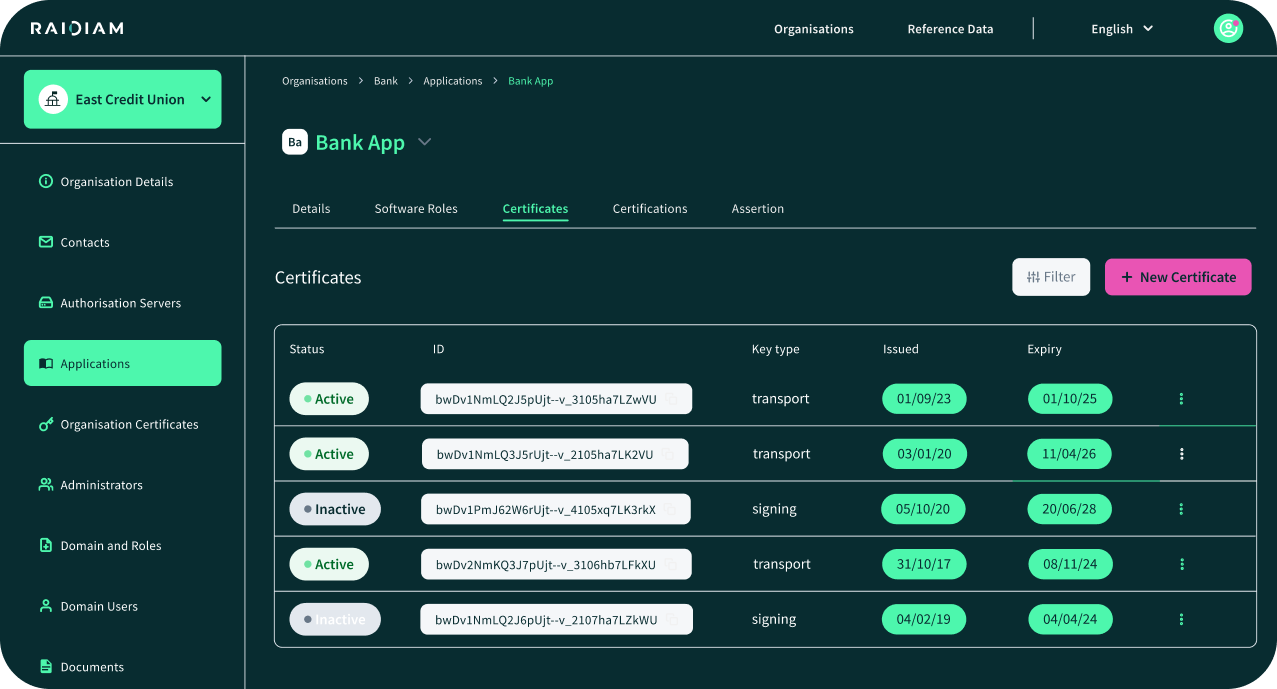Checklist: 10 Steps to Kickstart API Onboarding Success
When building an API ecosystem, strong policy and security foundations matter — but what really drives adoption is developer momentum. Once stakeholders understand why trust frameworks and standards like FAPI 2.0 or PCI DSS 4.0 matter, they need to know how to get started.
This practical checklist translates policy awareness into actionable steps for developers and technical teams. Whether you’re a fintech integrating with banks, or an enterprise opening APIs to partners, these 10 steps will help you move from concept to live, compliant integration faster.
1. Register Your Organisation
Every ecosystem starts with verified participants. Begin by registering your organisation in the central trust directory. This ensures that your identity and contact details are authenticated and discoverable to other participants.
Self-Service, Instant Trust Creation
In Raidiam Connect, this takes minutes via the self-service directory — each organisation is issued digital certificates that form the root of trust for all API interactions.
2. Set Up Your Developer Account
Log in to the developer portal and create an account for your technical team. The portal gives you immediate access to documentation, onboarding workflows, and sandbox environments. Link to your IDP for SSO access.
Your Hub for Seamless Registration and Testing
Connect’s developer portal provides a unified interface for registration, credential minting, and testing.
3. Create and Register Your Application
Define your app in the directory: name, purpose, redirect URIs, and contact information. This step binds your app identity to your organisation, enabling automated issuance of OAuth2 credentials and certificates.

4. Obtain Your Credentials Securely
Replace shared secrets with non-shareable, asymmetric credentials. Download your client certificate and public and private key pair, which will be used for mTLS or private_key_jwt authentication.
Effortless Credential Lifecycle—Meets the Toughest Security Standards
Raidiam Connect automates credential generation and lifecycle management, meeting FAPI 2.0 and PCI DSS 4.0 security expectations.
5. Test in the Sandbox
Run your first API calls in a controlled sandbox. Validate authentication, authorisation, and consent flows before connecting to production. Sandbox integration is part of the same self-service process — no manual whitelisting or VPN setup required.
6. Verify Conformance
Before going live, validate that your implementation meets the ecosystem’s standards. Use the conformance suite to test OAuth flows, security headers, and data models automatically.
Raidiam Assure integrates with Connect to provide automated pre-production and production testing for continuous compliance.
7. Enable Continuous Credential Rotation
Set up automated key rotation to prevent credential expiry or reuse. Continuous rotation ensures compliance with PCI DSS clause 8.3.2 and supports a zero-trust approach to machine identity.
8. Configure Fine-Grained Access Control
Define scopes, roles, and permissions aligned with least-privilege principles. Use a policy engine (like Raidiam Policy Engine) to auto-generate role-based access controls from your API specification.
→ Set up access control for your APIs. Determine what operations are apps permitted to perform. Learn more.9. Monitor and Audit
Use directory metadata and token logs to track every issued credential, API call, and participant. Regular monitoring ensures operational integrity and audit-readiness.
→ Test and Monitor Your APIs Before Partner Onboarding. Validate the entire journey of a client application against your APIs.10. Promote and Iterate
Once you’re live, share your APIs and encourage other developers to integrate. Use feedback from the portal’s analytics to improve documentation and streamline future onboarding.
Why It Matters
Successful API onboarding blends policy compliance with developer experience. When developers can self-register, test securely, and move to production without friction, ecosystems scale faster — safely. Raidiam Connect brings this full lifecycle together: registration, credentialing, conformance, and continuous compliance — all self-service, all under a trusted framework. So if you’ve just read our Private canvas this checklist is your next step: move from policy awareness to production readiness.
Practical Guide
Onboard Your First Partner in 30 Days - No Fluff, Just Code
Get the practical developer playbook with weekly steps, real configs, and copy-ready code to build, secure, and distribute your APIs fast.
Access Now →